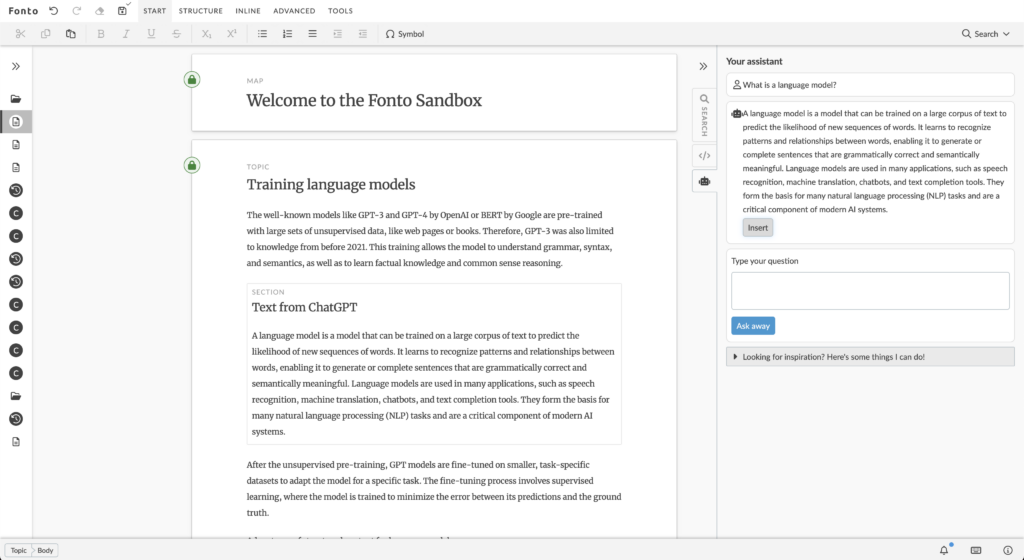Discover the power of structured content in the realm of generative pre-trained transformers (GPT), the groundbreaking technology revolutionizing language models. In this article, we’ll focus on how structured content enhances the training process, leading to easier data processing, improved accuracy, and enriched contextual understanding. While unstructured content has its merits, we’ll explore why a balanced combination of structured and unstructured data is vital for developing robust and versatile language models that excel in various natural language processing tasks.
And no, we didn’t write this introduction ourselves. It has been generated by ChatGPT, based on the article below. We asked ChatGPT to provide an attractive introduction for this article.
Generative pre-trained transformers
GPT in ChatGPT stands for generative pre-trained transformer. It’s an advanced language model, based upon the transformer architecture. Within a given context, the goal is to generate text by predicting the next word in a sequence. Being generative means that the model can generate new text based on learned patterns and structures from the training data. Based upon this data, it can be configured for tasks like question-answering or text summarization.
What is a language model?
Language models are predicting the likelihood of new sequences of words based upon analyzing the surrounding content. Language models do learn to recognize patterns and relationships between words. This enables the model to generate or complete sentences that are grammatically correct and semantically meaningful.
Language models are used in many applications, such as speech recognition, machine translation, chatbots, and text completion tools. They form the basis for many natural language processing (NLP) tasks and are a critical component of modern AI systems.
Training language models
The well-known models like GPT-3 and GPT-4 by OpenAI or BERT by Google are pre-trained with large sets of unsupervised data, like web pages or books. Therefore, GPT-3 was also limited to knowledge from before 2021. This training allows the model to understand grammar, syntax, and semantics, as well as to learn factual knowledge and common sense reasoning.
After the unsupervised pre-training, GPT models are fine-tuned on smaller, task-specific datasets to adapt the model for a specific task. The fine-tuning process involves supervised learning, where the model is trained to minimize the error between its predictions and the ground truth.
Advantages of structured content for language models
Structured content has several advantages over unstructured content when it comes to training language models:
- Easier data processing: the schema makes it easier for the algorithms to parse, process, and understand the data. This leads to more efficient training and potentially better results;
- Contextual understanding: metadata in structured content provides valuable context and additional information for the language model. This helps the model understand the semantics and relationships between different data elements more effectively;
- Improved accuracy: structured content is organized and follows a consistent structure, it can reduce the ambiguity and noise in the data. This leads to better performance, as the model can more easily identify patterns and relationships in the input data.
Although unstructured content also has its benefits for training a language model, according to ChatGPT: “It’s worth noting that language models can still benefit from unstructured content, as it can help them learn the natural variations, nuances, and complexities of human language. A combination of both structured and unstructured content can be ideal for training robust and versatile language models.“
How AI assistants can help you
Think for example of your Gmail email composer, that helps you to predict the next words in your sentence. This is trained upon your usage and language models. See for example the below message, where I start a sentence with ‘How’ and Gmail directly suggests ‘are you?’. This makes me far more productive.

And also in Fonto Editor, an AI assistant like ChatGPT can assist you. Not only with assisted writing, but also with more advanced tasks like summarizing content or putting answers to a question directly into your document. And once this content is part of your XML, you can again enrich the content, which will contribute to easier data processing and better contextual understanding, which in the end leads to improved accuracy. This will speed up productivity!


Customer Success Manager at Fonto – Passionate runner and Dad
